

The feedback continuum. The effects of feedback are more complex than we often realise.

While expertise and mastery is unlikely to develop without feedback it’s certainly not true to say that giving feedback results in expertise and mastery. There are few teachers who do not prioritise giving feedback and yet not all teachers’ feedback is equally effective. My understanding of the effects of feedback has grown as I’ve come to accept and internalise the profound differences between ‘performance’ and ‘learning’. If you’re not clear on these, I’ve summarised them here.
Hattie and Timperley point out that, “Feedback is one of the most powerful influences on learning and achievement, but this impact can be either positive or negative.” It’s interesting to consider the view from cognitive psychology. This might seem on first reading to contradict your lived experience. In the past I’ve used the analogy of navigation to explain this. Feedback: let’s build it in, not add it on.
Image: @jasonramasami The quantity of feedback our students need after completing a task is largely dictated by the quality of teaching they have received before and during this task.

I would argue that much of the best and most useful feedback our students receive happens as they are working, not necessarily after they have finished working. Let me explain. Last week, I was off sick for three days in a row, the longest illness I have had in nine years of teaching. Two stars and a bloody wish! A heap of epithets is poor praise: the praise lies in the facts, and in the way of telling them.Jean de La Bruyère We are held hostage by our superstitious belief in the mystical power of marking to cure all educational ills.

It won’t. A teacher inscribing marks in students’ exercise books is every bit as mundane as it sounds; in my 15 years in the classroom it rarely resulted in much. But that’s not really why we mark. We mark because it’s the right thing to do. Recently I’ve been working with a school to help them rethink their marking policy. Is praise counter productive? I had an interesting discussion with Tim Taylor this morning.

He said, “At best, praising effort has a neutral or no effect when students are successful, but is likely to be negative when students are not successful.” But what could possibly be wrong with praise? Surely praise is one of the most fundamental way to motivate pupils? Teachers are, generally, keen to praise pupils, and pupils , generally, welcome and expect it. We use praise to reward or change pupils’ behaviour, and to that extent it may well be effective. But although there are some who cast aspersions on the concept of engagement, we all want our pupils to make greater effort, don’t we? When students were praised for effort, 90 percent of them wanted challenging new tasks they could learn from. ” This is pretty clear, isn’t it? Www.ascd.org/ASCD/pdf/journals/ed_lead/el201209_ChappuisOnlineFigure.pdf. Educational Leadership:Feedback for Learning:"How Am I Doing?"
Giving Feedback - The Art of Coaching Teachers. UserID:
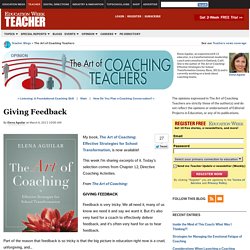
From The Brilliant Report: How To Give Good Feedback. Monday, March 18, 2013 When effectively administered, feedback is a powerful way to build knowledge and skills, increase motivation, and develop reflective habits of mind in students and employees.
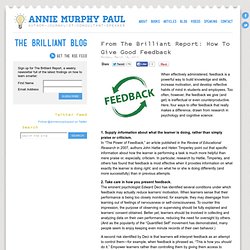
Too often, however, the feedback we give (and get) is ineffectual or even counterproductive. 5 Research-Based Tips for Providing Students with Meaningful Feedback. In recent years, research has confirmed what most teachers already knew: providing students with meaningful feedback can greatly enhance learning and improve student achievement.

Professor James Pennebaker from the University of Texas at Austin has been researching the benefits of frequent testing and the feedback it leads to. He explains that in the history of the study of learning, the role of feedback has always been central. When people are trying to learn new skills, they must get some information that tells them whether or not they are doing the right thing. Learning in the classroom is no exception. Both the mastery of content and, more importantly, the mastery of how to think require trial-and-error learning. The downside, of course, is that not all feedback is equally effective, and it can even be counterproductive, especially if it's presented in a solely negative or corrective way.
An ASCD Study Guide for How to Give Effective Feedback to Your Students. By Susan M.
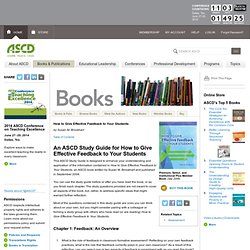
Brookhart This ASCD Study Guide is designed to enhance your understanding and application of the information contained in How to Give Effective Feedback to Your Students, an ASCD book written by Susan M. Brookhart and published in September 2008. You can use the study guide before or after you have read the book, or as you finish each chapter. The study questions provided are not meant to cover all aspects of the book, but, rather, to address specific ideas that might warrant further reflection. Most of the questions contained in this study guide are ones you can think about on your own, but you might consider pairing with a colleague or forming a study group with others who have read (or are reading) How to Give Effective Feedback to Your Students.
Express 6.10 - Tips for New Teachers: Goodbye to "Good Job!"—The Power of Specific Feedback. Margaret Berry Wilson Your principal has come to your classroom to observe a lesson.
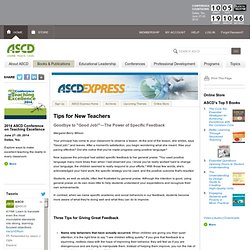
At the end of the lesson, she smiles, says "Good job! ," and leaves. After a moment's satisfaction, you begin wondering what she meant. 7 Key Characteristics Of Better Learning Feedback. 7 Key Characteristics Of Better Learning Feedback by Grant Wiggins, Authentic Education On May 26, 2015, Grant Wiggins passed away.
20 Ways To Provide Effective Feedback For Learning - 20 Ways To Provide Effective Feedback For Learning by Laura Reynolds While assessment gets all the press, it is feedback for learning that can transform a student’s learning.
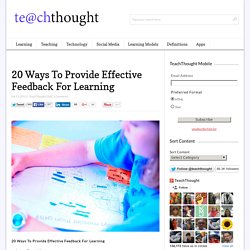
When feedback is predominately negative, studies have shown that it can discourage student effort and achievement (Hattie & Timperley, 2007, Dinham). Like my experience, the only thing I knew is that I hated public speaking and I would do anything possible to get out of it. As a teacher, most of the time it is easy to give encouraging, positive feedback. Understanding Learning Feedback For Better Teaching. 20 Ways To Provide Effective Feedback For Learning -
Teacher Evaluation: What's Fair? What's Effective?:The Potential of Peer Review. November 2012 | Volume 70 | Number 3 Teacher Evaluation: What's Fair? What's Effective? Pages 20-25 Susan Moore Johnson and Sarah E. Fiarman. 20 Useful Web Design Feedback Solutions. Designers create designs which will be used by lots of people, so to measure how well a content page performs with users, they need to get an outside perspective to spot issues and validate design choices. One of the most critical parts of a project is getting critiques and advice on how to improve designs. Thanks to the web’s ability to connect us to people from all over the world, getting feedback for a web design has never been easier. Online annotation tools for collaboration and getting feedback for web design and development projects. They are very useful for commenting, review and debugging with client and as well as with the team members. There’s always a feedback stage in the web design process which requires intensive interaction.
Improve Feedback with Voice Comments in Google Docs. As a former teacher of writing, I understand (and greatly value) the importance of feedback in the writing process. With the emphasis that the Common Core Standards place on students using evidence from sources and engaging in rich and rigorous evidence-based conversations about text, we, as educators, need to find more ways to provide frequent, meaningful feedback to students as they gain increasing independence in writing tasks. Despite the vast availability of technology to produce works of writing electronically, the method of providing feedback still remains quite similar – written comments that the student must read and interpret to make necessary adjustments.
For Google Docs users, the process of reviewing student work and leaving feedback is relatively simple, yet it still requires written comments, which can be limiting based on space and time constraints. Ideally, we would be able to meet with each student and talk to them as they progress through their work. Interested? 1. Feedback for Learning:Seven Keys to Effective Feedback. Types of Feedback and Their Purposes. Improve Feedback with Voice Comments in Google Docs. On Feedback. My article on feedback is the lead article in this month’s Educational Leadership. I provide a clear definition of what feedback is and (especially) what it ISN’T. Feedback is not advice (e.g. Use more detail!) , nor is it evaluation (e.g. Good job!) You can read the article online here.
13 Concrete Examples Of Better Feedback For Learning. By Grant Wiggins As readers may know, my article on feedback in the September edition of Educational Leadership has been one of the most widely read and downloaded articles of the year, according to ASCD data. That’s gratifying feedback! I blogged about it here, while also providing the longer article I originally provided the editors – they cut my piece in half for publication, as editors are wont to do – and also shared in the blog a wonderful follow-up email from a teacher on how to use the contents of the article.
Feedback for Learning:Seven Keys to Effective Feedback.